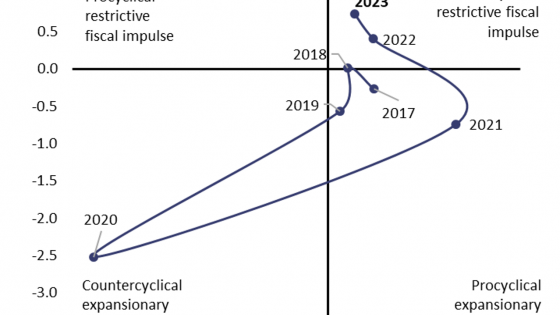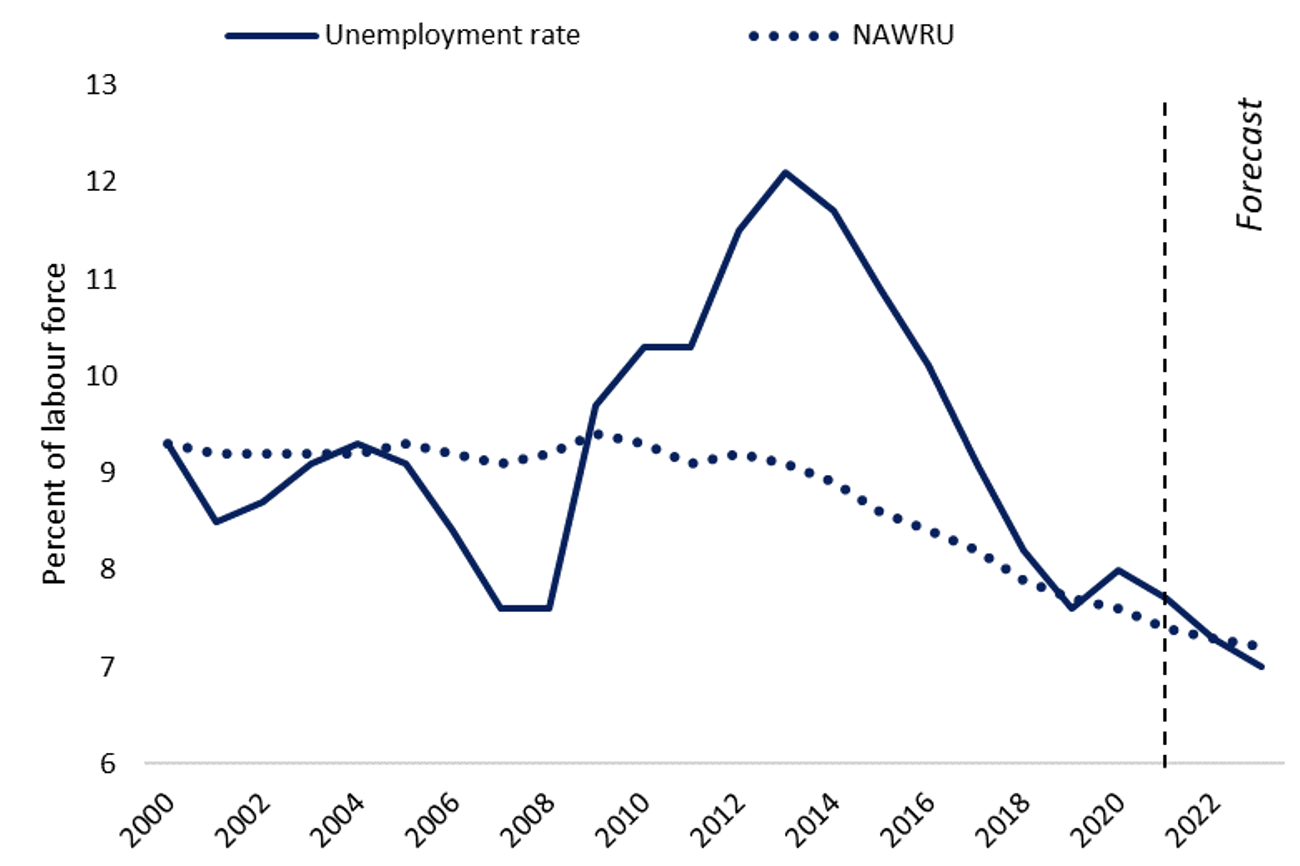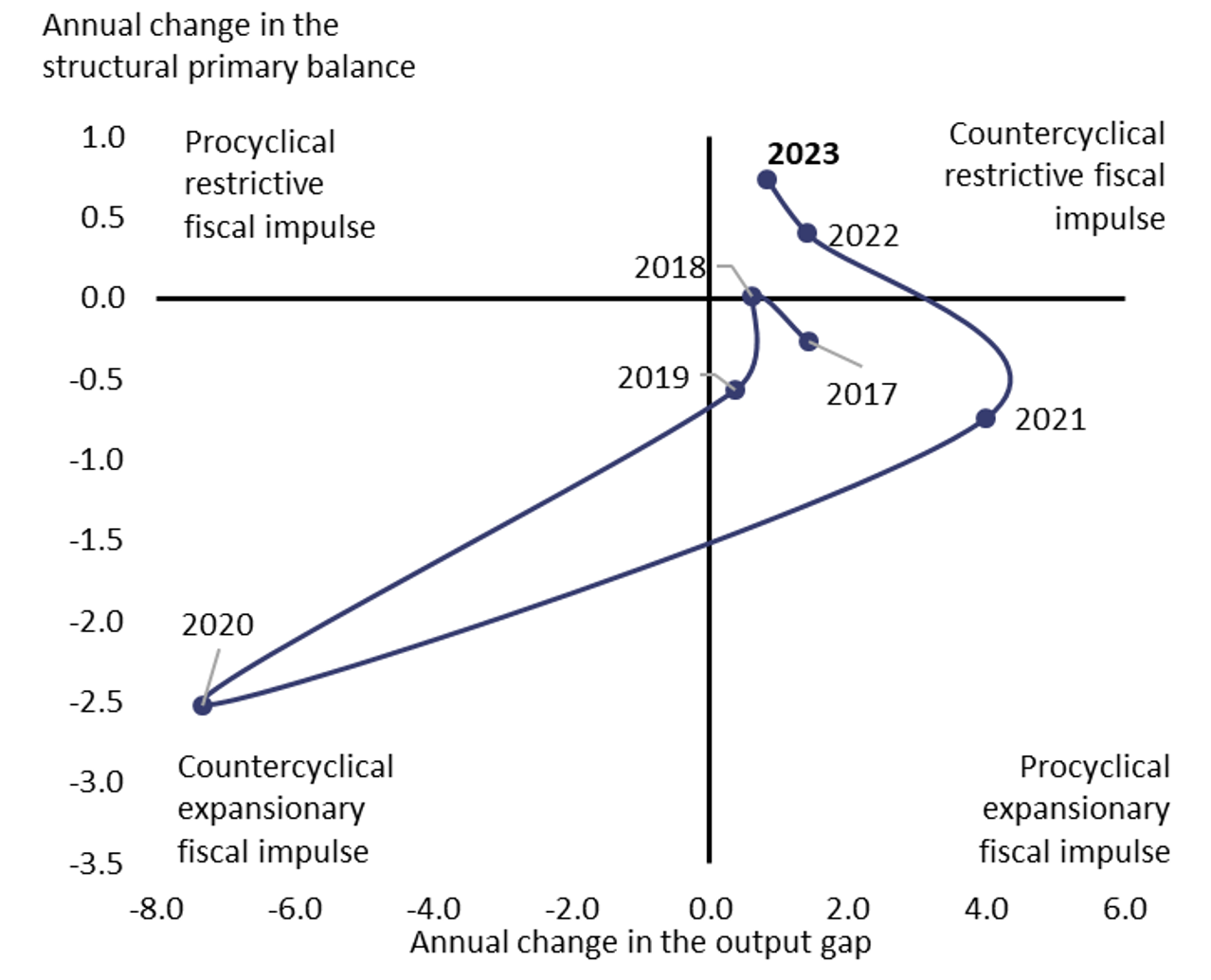The war in Ukraine has clouded the near-term economic outlook. After a sharp downturn due to the Covid-19 pandemic, the euro area economy was set to continue to recover strongly well into 2023. In its latest forecast, the European Commission projects economic activity in the euro area to grow at a lower but still solid rate (slightly above the pre-pandemic average), while downside risks have intensified.
Despite the weaker outlook, real output in the euro area and the EU should exceed 2019 levels already in 2022 and is expected to continue to grow in 2023. The Commission’s spring forecast estimates that the output gap will be closed or slightly positive in 2023. Similarly, the unemployment rate would fall to 7%, the lowest rate since the adoption of the euro. Meanwhile the ECB projects headline inflation to halve from its peak in 2022 to about 3.5% in 2023 (ECB 2022), a benign view in light of repeated upside surprises in recent months. Should inflation prove more persistent than expected, the risk of igniting a wage-price spiral would substantially increase, and with it, the likelihood of a significantly stronger tightening of financial conditions.
Figure 1
a) Recovery of euro area real GDP (2019=100)
Source: European Commission
b) Euro area unemployment rate
Source: European Commission
Note: NAWRU refers to the non-accelerating wage rate of unemployment.
Assessment of the appropriateness of the euro area fiscal stance in 2023
The withdrawal of fiscal support is expected to continue in 2023, as governments phase out the pandemic-related emergency measures and gradually rebuild buffers. At current policies, the euro area fiscal stance (i.e. the structural primary deficit) is expected to tighten by 0.7 percentage points of GDP to 1.3% in 2023. Thus, pending the preparation and adoption of government budgets for 2023, the fiscal impulse (i.e. the change in the structural primary balance) is expected to be moderately restrictive for the second year in a row. The overall fiscal stance would nevertheless remain supportive. The likely new discretionary measures in response to the war, including to protect purchasing power of vulnerable groups, are not yet fully reflected in these forecasts.
The war intensified a deterioration in the terms-of-trade that had started mid-2021. Faced with limited options to substitute away from energy and food imports, the euro area economy experienced a sizable income loss and more severe supply constraints. At the same time, aggregate demand (private consumption and investment) remained strong on the back of post-pandemic momentum, feeding domestic inflationary pressures. Against this backdrop, stimulating demand could only prove counterproductive and run counter ECB’s efforts to better align supply and demand.
Consequently, the EFB considers a moderately restrictive fiscal impulse in 2023 to be appropriate. Current fiscal policies are broadly in line with this recommendation. That is not to say that fiscal policy should not respond to the shock. Governments could and should take targeted and temporary measures aimed at mitigating the costs to vulnerable households while also pursuing fiscal consolidation. This requires effective spending prioritisation to preserve nationally-financed public investment.
Figure 2
a) Euro area fiscal impulse over time
b) Fiscal impulse, cyclical conditions and sustainability across Member States in 2023
Source: European Commission.
Note: Fiscal impulse includes the impact of RRF grants (based on cash disbursements).
Faced with an uncertain outlook, fiscal policy must of course remain agile without sacrificing medium-term debt reduction. During the pandemic, government debt ratios rose in most Member States, pushing the euro area debt-to-GDP ratio above 100%. Still low sovereign borrowing costs, solid economic growth and higher inflation are temporarily alleviating pressures on debt ratios. Yet nominal growth is set to normalise while government’s marginal borrowing costs have already gained more than 200 basis points since late 2021 in most member states. The EFB agrees with the Commission on the need to move to prudent fiscal positions and put government debt firmly on a downward path, especially in high debt countries. This would achieve a well-coordinated mix of fiscal and monetary policies, while rebuilding fiscal buffers.
Continued application of the severe economic downturn clause
In contrast to earlier announcements, the severe economic downturn clause will still apply in 2023 (European Commission 2022b). The Commission had previously communicated that the decision to continue to apply the clause would be taken on the basis of an overall assessment involving with the level of economic activity in the EU or euro area compared to pre-crisis levels (end-2019) as the key criterion. This criterion is already met as of 2022 and the war in Ukraine is not expected to change this. However, the Commission argued in May 2022 that the economy had not returned to ‘normal conditions’, and that the considerable uncertainty surrounding the outlook justified an extended application of the clause.
This has implications for the pursuit of an appropriate euro area fiscal stance. As the clause remains in place, the Commission has again issued largely qualitative country-specific guidance to Member States for 2023 (European Commission 2022a). Some broad goalposts were given to ‘high debt’ and ‘low/medium debt’ countries, mostly regarding nationally-financed current expenditure growth. However, the guidance does not allow to derive any clear recommendation on the aggregate fiscal impulse for the euro area as a whole. In the absence of quantitative recommendations anchored in agreed fiscal rules and procedures, the appropriate euro area fiscal stance is less likely to be delivered.
The decision to also apply the clause in 2023 based on a new economic rationale has underscored the extensive discretion available to the Commission. Such discretion, at times when the Stability and Growth Pact itself is under scrutiny for reform, reduces the predictability of fiscal trajectories precisely when increased policy uncertainty is undesirable. The EFB is very much looking forward to the Commission’s orientation on a possible review of EU economic governance scheduled for autumn this year, and how it intends to implement current rules in case the EU political leadership cannot seem to reach an agreement on the main elements of a legislative reform in time for the next round of country-specific recommendations.
References
European Central Bank (2022), “Macroeconomic projections”, 8 June.
European Commission (2021), “One year since the outbreak of COVID-19: fiscal policy response”, 3 March.
European Commission (2022a), “2022 European Semester: Country Specific Recommendations / Commission Recommendations”, 23 May.
European Commission (2022b), “Commission presents fiscal policy guidance for 2023”, 2 March.
European Fiscal Board (2021), “2021 annual report of the European Fiscal Board”, 10 November.
Thygesen et al. (2021), “Fiscal support for a sustainable recovery in the euro area”, VoxEU.org, 16 June.
Verwey et al. (2022), “Russian invasion tests EU economic resilience”, VoxEU.org, 20 May.







